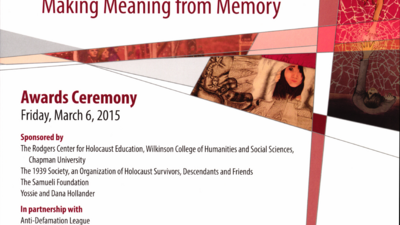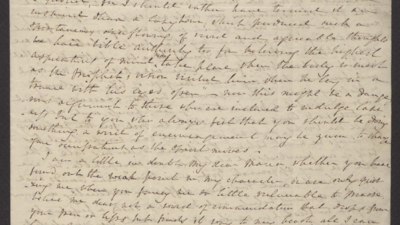Oral History Interview with Armand Mednick
Title
Date
Contributor
Summary
Armand Mednick, named “Avrum” by his Yiddish-speaking parents, was born in 1933 into a close, extended family in Brussels, Belgium. He grew up as a stranger in a non-Jewish neighborhood, often taunted by anti-Semites influenced by the fascist Rex Party. At age six, he was hospitalized with tuberculosis until May 1940, when his father, an active political leftist, fled with his family to France. His father was drafted into the French Army, deserted and placed his son, renamed “Armand”, in a sanitarium at Clermont-Ferrand in the Auvergne Mountains. Armand’s father, mother and baby sister hid nearby in Volvic, where they passed as Christians. When Armand recovered, he joined his family and attended Catholic school. At home, there was some Jewish observance and Armand recalls walking for seven miles with his father to attend a clandestine seder.
Armand’s father joined the French resistance in 1944 and the family returned to Brussels in 1945, where Armand was the first Bar Mitzvah celebrant after the war. The Mednick family moved to Philadelphia in 1947. Buchenwald death lists confirmed that most of their extended family of 55 relatives had been killed. Armand became a potter and teacher and produced a series of clay reliefs with symbolic Holocaust images, in an attempt to exorcise his painful childhood memories.
See also interview with his father, Bernard S. Mednicki.
Interviewee: MEDNICK, Armand Date: June 15, 1983
none
More Sources Like This
of
Zenek Maor
Zenek Maor, was born August 9, 1923, in Wloclawek, Poland, into a religious Jewish family. His father was a factory owner and the family lived comfortably until the German occupation. He details pre-war life including his HashomerHatzairactivities. He describes German restrictions and brutalities in Wloclawek, where his father was arrested and held for ransom, and later in Warsaw, where his family fled in January 1940. As a 16 year-old, he worked in various forced labor brigades, including the Okecie air-field in Warsaw. He gives detailed descriptions of life in the Warsaw ghetto including Jewish police and the HashomerHatzairnetwork of underground schools. Because of severe hunger in the ghetto, he was encouraged by his family to escape in 1942.
Eventually sent to various labor camps, he details difficult work conditions but mentions ongoing belief in his own survival. He discusses reasons that people could not escape from labor camps or from Auschwitz. He details his arrival at Auschwitz in summer 1943 including initial belief in the slogan “Work Makes You Free,” the smell of roasting flesh, and his defiance of Mengele’s decision to send him to annihilation with other children instead of assigning him to work with his older brother. Much information is given on Auschwitz: daily routine, work, treatment by Kapos, latrine communication between prisoners. He describes the death march from Auschwitz from January 17, 1945 to May 10, 1945 and gives an in-depth account of his liberation by the Russian Army. Returning to Poland, he learns that no one from his family survived. He emigrated to Palestine in April, 1947.
This interview was conducted in Haifa, Israel.
of
Eva Cutler
Eva Cutler, née Frederich, was born in 1925 in Budapest, Hungary, the second child of a cultured, Jewishly emancipated family. She describes her family’s change from being unaware of existing Hungarian antisemitism and of Nazi persecutions of Jews elsewhere, to growing dread under government imposed restrictions, almost secret attempts to emigrate, along with continuing disbelief. She tells of varied attitudes of Hungarians under German occupation and help given by some non-Jews, even a German administrator. Her brother was inducted into a work brigade and later her father was taken away.
In the fall of 1944, Eva—along with many other young Jewish women—was herded out of Budapest. She details horrendous conditions and brutality during the death march to Bergen-Belsen. She witnessed a mass execution of men. A German army officer helped her walk so she could keep going. Some townspeople offered food to the marchers, others abused them. She mentions a brief encounter with Wallenberg at the Austrian border, where he saved those who had Swiss or Swedish protective passes or said they had. Eva arrived at Bergen-Belsen in January 1945 after enduring a prolonged cattle car ride. She describes how survivors suffered from continued deprivation and illness there and also had to cope with hostility from Polish and Czech Jews already there. After liberation in April, she learns that her parents survived in Budapest and her brother is presumed dead. Eva was sent to Sweden for recovery and rehabilitation by the Red Cross. She praises the excellent medical care and kindness she experienced there. She came to the United States in 1946. Her parents came to the United States via Canada, after Eva attained U.S. citizenship. She closes with an account of her return to Hungary after 37 years and stresses the brotherhood of man.

This document is a program for the 16th Annual Holocaust Art & Writing Contest, an event presented by Chapman University and The 1939 Society, with its awards ceremony held on March 6, 2015. The program details the contest's theme, "From Discovery to Action: Making Meaning from Memory," and acknowledges various sponsors, partners, and individuals involved as speakers and judges. It also includes information on a related "Evening of Holocaust Remembrance" held on April 16, 2015, which commemorated the 70th Anniversary of Liberation. A significant portion of the program features student artwork and a detailed biography of Holocaust survivor Jack Pariser, highlighting his remarkable story of survival during the Holocaust. Additionally, the program lists the numerous middle and high schools from across the United States and one from China that participated in the contest. The document serves as a comprehensive record of the event, its participants, and its educational mission.
of
Moshe Moskowitz
Moshe Moskowitz was born in 1922 in Lespitz-Baya, Romania to a merchant family that was traditional but not deeply religious. He studied in a Jewish school, then in a vocational school. He planned to go to Palestine, joined a Zionist youth group and worked in an agricultural community. After the German occupation, Jews were transferred from the villages to the large cities, and many were sent to forced labor camps. His Zionist youth group became active in the resistance. Moshe took on Aryan identity, as did others who had contact with Zionist emissaries in Constantinople and Switzerland. Emissaries from England and the U.S. often attended the resistance meetings. The diplomatic courier who carried letters from the resistance betrayed them, and those who were arrested were sent to camps in Transnistria.
Moshe and his group smuggled children out of camps, gave them false identities, and set up cultural activities until they could be processed to go to Palestine on illegal immigration on ships. In 1944, British-trained parachutists from Palestine landed in Romania and Moshe’s Zionist group was among those who gave them identity papers, living quarters and maps to help them reach Bucharest. They also helped German, American and English prisoners-of- war in Brasov with money, clothing and medicine. After liberation, they rushed to the American and British zones to take Jewish prisoners out of the range of German bombings. Moshe was in charge of the funds through the Landsmanshuteyfor such operations. Groups who were involved in saving children maintained connections in Israel. Moshe emigrated to Israel post-war.
of
Liza Kessler
Liza Kessler, nee Rak, was born in the Ukrainian town of Vinnitsa, located on the Polish border between Kiev and Odessa. A center of Jewish learning, it boasted 15 Jewish schools. Liza graduated from a Jewish high school, married and had two children. Liza describes how in July, 1941, after a German bombing raid, Polish Jews fled into her town. She heard reports from them that the Jews were herded into the synagogue and burned. Liza with her two children, and sisters-in-law and their children fled with the ‘echelons’ (transports which carried machinery). They boarded a barge for Central Asia. In November, 1941 they arrived in Georgia. They stayed on a kolkhoz (collective farm) until the Germans came. They then fled further East to Uzbekistan, finally landing in Bukhara where they stayed until the end of the war. Liza describes harsh conditions: food rationing and bitter cold. Liza’s sisters and parents were murdered in mass killings.
After World War II Liza went back to Poland with her second husband, a Jewish Polish national. Because it was too much like Russia, they left and were smuggled into the American zone in Austria via Czechoslovakia. Liza and her family stayed in Austria for five years. They were aided by the UNRRA (United Nations Relief and Rehabilitation Administration). Finally, in 1950, through an aunt in Philadelphia they received papers and were able to enter the United States as part of the quota.
Interviewee: KESSLER, Liza Date: January 18, 1983
